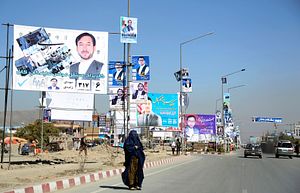On October 20, 2018, Afghans will head to the polls for the third round of parliamentary elections since the ouster of the Taliban in 2001. The steady accusations of fraud, corruption, lack of transparency, and undue interference in the days leading up to voting underscore growing disillusionment about the electoral process in Afghanistan. A new biometric voting system, intended at keeping corruption at bay, had yet to become operational as of three weeks before the vote. With over 2,400 U.S. military casualties in the ravaged country and a trillion dollar bill on taxpayers to date, U.S. policymakers have good reason to be anxious about this upcoming test of democratic governance.
My organization, the Afghanistan Institute for Strategic Studies, recently surveyed 1,305 individuals across 13 Afghan provinces to understand what parliamentary elections mean to average Afghans and how their insights could inform electoral reforms. Our analysis found that elections failed to create any form of meaningful representation on the part of elected officials. In past elections, parliamentary candidates lacked any clear political agenda (and the current campaign period is showing reasons for similar concern, with some candidates promising a “luxury lifestyle” in Kabul). Afghans have thus come to expect little from elected officials – and government services by extension – as MPs all but disappear once voting is complete.
Our analysis found that a staggering 53 percent of respondents felt that “elected MPs simply pursued personal interests” rather than representing their constituents. One respondent from Faryab province commented on the prevailing reality: “The ordinary voters cannot get what they want. They have no faith in the elections. Those who won previous elections didn’t fulfill their responsibilities.”
While dissatisfaction with elected officials is a hallmark of many political systems, the accountability deficit in Afghanistan stems from the problematic structure of the electoral system. Afghanistan is one of only three countries globally that follows the single non-transferable vote (SNTV) system for parliamentary (Wolesi Jirga) elections. Voters cast a single vote among multiple candidates running for multiple positions within a single constituency at the provincial level.
Research on parliamentary elections reveals the devastating results of the current system. During the 2005 and 2010 parliamentary elections, 35 percent of the vote on average went to winning candidates with the remaining 65 percent being spent on losing candidates. This absurd outcome is possible under the SNTV system since the more candidates that run, the fewer votes one needs to actually secure victory.
Since the early days of Afghanistan’s reconstruction, experts warned how the SNTV system inevitably leads to a wholly unrepresentative parliament. During the 2005 elections, 21 of the 33 candidates elected from Kabul received less than 1 percent of the vote. This same dynamic was found in the 2010 elections in which the leading MP in Kabul received just 3.6 percent of the vote. Such a result is not only disturbing but also has serious implications for Afghan “representative democracy.” The SNTV system is also highly prone to fraud (in 2005, three provinces had over 100 percent turnout) since small changes in the vote count can drastically alter the outcome.
Political parties are an essential component of democratic governance and could help to keep MPs in check. However, Afghans maintain a lingering distrust of parties as they conjure bitter memories of Communist repression in the 1970s and 80s, followed by the mujahideen groups that provoked civil war in the 1990s.
At present, parties remain dominated by ethno-politics and seek the patronage of their own ethnic group. Merely 21 percent of respondents supported greater presence of political parties in parliament; conversely, the vast majority (63 percent) preferred independent candidates. The nature of the SNTV system further undermines political alliances, since all candidates are effectively competing against one another within a constituency.
The silver lining in our research was that 69 percent planned to vote in upcoming elections, suggesting that people still maintain a level of hope in the process. Further, 55 percent expressed their approval of the majoritarian system of voting, an indication that an “elections culture” seems to be slowly taking root and shaping people’s preferences.
Fixing Afghanistan’s broken electoral system requires reforms that alter its fundamental operation. Our research recommends three significant changes. First, the size of a constituency – the entire province – is too large to promote accountability and must be reduced. Fifty-six percent of respondents confirmed that electoral boundaries should be redrawn.
Second, the Afghan government must enact legislation regulating political parties. Our survey revealed that Afghans feel caught in a catch-22 situation in which political parties should represent national interests in theory but remain mired in ethno-nationalism in practice. Enacted laws can help establish transparency standards for party funding, methods of electing party leadership, and means of holding MPs accountable within the party caucus.
Third, the country should shift toward a “combined” SNTV and single-member constituency system. As path dependent reforms are the most likely to gain widespread acceptance, a gradual shift to another majoritarian process – where a single MP represents a constituency – would be the most viable option. The single-member system should apply to all male candidates, running in smaller constituencies. The Afghan Constitution reserves 68 of the 250 seats in parliament for women. Thus, the SNTV system should be temporarily preserved for female candidates to ensure representation until separate single-member electoral boundaries can be drawn to distribute their allocated seats.
If the international community seeks to support Afghanistan’s democratic institutions, it should engage with the Afghan government to find solutions for the ultimate recipients of reform: The Afghan people.
Nafay Choudhury is a Research Fellow at the Afghan Institute for Strategic Studies and a Ph.D. Researcher at King’s College London, where his work theorizes on the relationship between legal and social norms in developing societies.

































